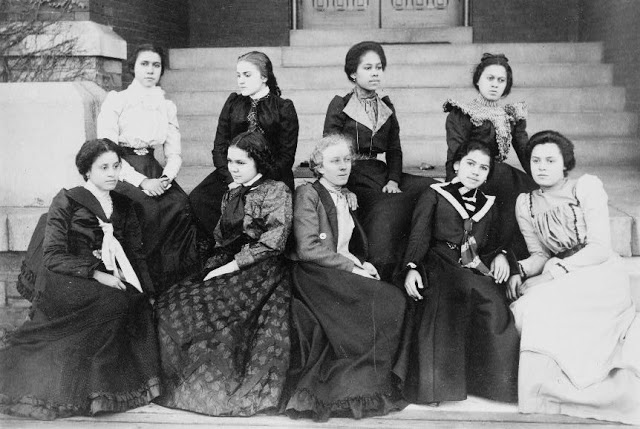THE CHANGE
So what were some of the motives for this grand, historic change? As we have taken a look at history, it is clear that women's long held role was to be the keeper or the “queen” of the home.[5] During the early 1900’s many men and husbands were away at war. Women without their husbands had very few rights. They were not able to be active in the community without being escorted by their husbands or an older woman. It was difficult for women to receive education or be active in the work force. A woman’s sole dominion was her home. The world outside was thriving with new innovations and inventions; all the while the women were still confined to their ever-standing responsibilities in their homes. It is hard to imagine one not becoming restless and wishing to fully engage with the ever-changing world. Of this subject, Gertrude Atherton, a California novelist agreed eight of ten women, she claimed, were “possessed with an eager, restless, desire to be somebody, rise above the masses.” “women...are writing, painting, journalizing, creeping into public offices, and flocking to the stage.” Women without any particular talent had the desire “to be independent, to strike out for themselves, to be something more than domestic nonentities.”[6] The Women’s Suffrage movement during this time was rapidly growing and emerging, and by 1920 women were granted the right to vote, and just a few years later an amendment was proposed to the Equal Rights Law. Women began gaining access to education, and they were finding their way into the workforce. Women wanted to be independent. They no longer wanted to feel like they needed to rely on a man for support. Women desired to support themselves, they wanted to be active in the community, and wanted to be educated and working. And above all they wanted to govern their own lives. 


This restlessness grew into one of the most drastic changes America has ever seen when it comes to Women. Women changed on nearly every front. Their once vital roles as wife and mother became less prevalent. Some women no longer felt the need to get married, or have children. The style of clothing changed from tight corsets and extremely modest dresses where the whole body was covered, to short, free flowing dresses where much of the body was exposed. The hairstyles also changed drastically during this time period. Women who used to commonly wear their hair long and braided as was common in the late 1800’s, cut it short as the flapper era arose during the 1920’s. Women began wearing makeup and jewelry. Many women began to smoke. Even the types of shoes changed. These changes were drastic as well as shocking to many American citizens.
 One hundred year old Roy Latham, born in 1896, lived through magnificent changes in American history. Ray was alive through through two world wars. He witnessed the invention of television, radio, airplanes, cars, and computers. When Latham was questioned about specific things and events that intrigued him in his long life, he responded that it was when women began to cut their hair short. He reported being taken aback by this new trend in hairstyles. He said “When I was a boy, all the girls had long braids… They had hair clear down to their waist. When they started to cut their hair, I said. ‘Why that’s plum crazy’”.[7] With a man who witnessed some of America’s greatest innovations, doesn’t it seem interesting that a point that stood out to him so much was when women cut their hair? It becomes clear that Ray’s response is a reflection of quite possibly many responses of people during this momentous time in history.
One hundred year old Roy Latham, born in 1896, lived through magnificent changes in American history. Ray was alive through through two world wars. He witnessed the invention of television, radio, airplanes, cars, and computers. When Latham was questioned about specific things and events that intrigued him in his long life, he responded that it was when women began to cut their hair short. He reported being taken aback by this new trend in hairstyles. He said “When I was a boy, all the girls had long braids… They had hair clear down to their waist. When they started to cut their hair, I said. ‘Why that’s plum crazy’”.[7] With a man who witnessed some of America’s greatest innovations, doesn’t it seem interesting that a point that stood out to him so much was when women cut their hair? It becomes clear that Ray’s response is a reflection of quite possibly many responses of people during this momentous time in history.
No comments:
Post a Comment